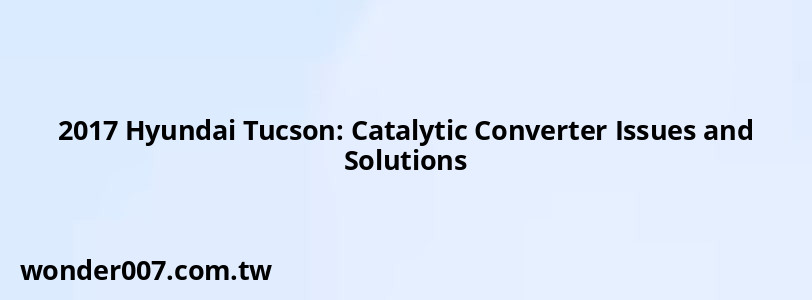2017 Hyundai Tucson: Catalytic Converter Issues and Solutions

The 2017 Hyundai Tucson has been reported to have several issues related to its catalytic converter, which can significantly impact vehicle performance and emissions. Owners often seek information regarding symptoms, potential causes, and solutions for these problems.
Common Catalytic Converter Problems
The catalytic converter in the 2017 Hyundai Tucson is known for experiencing specific issues, including:
- Clogging: Many owners report that the catalytic converter becomes clogged, leading to reduced engine performance and increased emissions.
- Failure Codes: The check engine light may illuminate due to catalytic converter failure, often indicated by codes such as P0420, which signifies that the catalyst system efficiency is below threshold.
- Oil Consumption Issues: Some Tucson owners have noted excessive oil consumption, which can lead to oil entering the catalytic converter and causing it to fail prematurely.
Symptoms of a Failing Catalytic Converter
Recognizing the signs of a failing catalytic converter is crucial for timely intervention. Common symptoms include:
- Reduced Engine Power: A noticeable decrease in acceleration and overall power can indicate a clogged converter.
- Check Engine Light: Frequent illumination of the check engine light can signal problems with the catalytic converter or related components.
- Rattling Noise: A failing catalytic converter may produce a rattling noise during startup or acceleration.
- Failed Emissions Test: If your vehicle fails an emissions test, it may be due to a malfunctioning catalytic converter.
Causes of Catalytic Converter Failure
Several factors contribute to catalytic converter issues in the 2017 Tucson:
- Oil Leaks: Excessive oil consumption can coat the catalyst substrate, leading to clogging and eventual failure.
- Debris Accumulation: Some vehicles have reported debris buildup within the catalytic converter, affecting its efficiency.
- Neglected Maintenance: Lack of regular maintenance can exacerbate issues related to the exhaust system and lead to premature failure.
Solutions for Catalytic Converter Problems
If you encounter problems with your Tucson's catalytic converter, consider the following solutions:
- Replacement: In many cases, replacing the catalytic converter is necessary. Aftermarket options are available at a significantly lower cost than OEM parts.
- Addressing Oil Consumption: If excessive oil consumption is identified, it should be addressed before replacing the catalytic converter to prevent future failures.
- Regular Maintenance: Keeping up with regular vehicle maintenance can help identify potential issues early and prolong the life of your catalytic converter.
| Solution | Description |
|---|---|
| Replacement | Install a new or aftermarket catalytic converter. |
| Oil Leak Repair | Fix any underlying oil consumption issues before replacing the cat. |
| Regular Maintenance | Conduct routine checks on exhaust system components. |
FAQs About 2017 Hyundai Tucson Catalytic Converter Issues
- What should I do if my check engine light is on?
If your check engine light is illuminated, it’s important to have your vehicle diagnosed as soon as possible. This could indicate a problem with the catalytic converter or other components. - How much does it cost to replace a catalytic converter?
The cost of replacing a catalytic converter can vary widely but typically ranges from $1,000 to $2,500 depending on whether you choose OEM or aftermarket parts. - Can I drive my Tucson with a failing catalytic converter?
While it may be possible to drive short distances, it is not advisable as it can lead to more severe engine damage and increased emissions.
In summary, if you own a 2017 Hyundai Tucson and experience any symptoms related to the catalytic converter, addressing these issues promptly is essential for maintaining vehicle performance and compliance with emissions standards.
Related Posts
-
2007 Dodge Ram 1500: Catalytic Converter Replacement Guide
27-01-2025 • 144 views -
BMW SOS Warning Light: Causes and Solutions
26-01-2025 • 204 views -
Hyundai Equus Air Suspension Shut Off
30-01-2025 • 217 views -
Toyota Sienna Alarm: Troubleshooting Common Issues
28-01-2025 • 202 views -
2013 Hyundai Sonata MAF Sensor: Location Guide
27-01-2025 • 177 views
Latest Posts
-
Rear Brake Caliper Piston Won't Compress
01-02-2025 • 356 views -
2015 Chevy Traverse AC Recharge Port Location
01-02-2025 • 409 views -
Are O2 Sensors Covered Under Warranty
01-02-2025 • 376 views -
How To Turn Off Paddle Shifters Mercedes
01-02-2025 • 377 views -
Power Steering Fluid Leak On Passenger Side
01-02-2025 • 457 views
Popular Posts
-
EPC Warning Light: What It Means for Your Vehicle
27-01-2025 • 630 views -
Hino Warning Lights: Understanding Dashboard Alerts
26-01-2025 • 765 views -
V12 Engine Costs: What You Need to Know
26-01-2025 • 679 views -
EPC Light: Understanding Causes and Solutions
26-01-2025 • 1053 views -
Power Steering and ABS Light On: Causes and Solutions
27-01-2025 • 643 views
